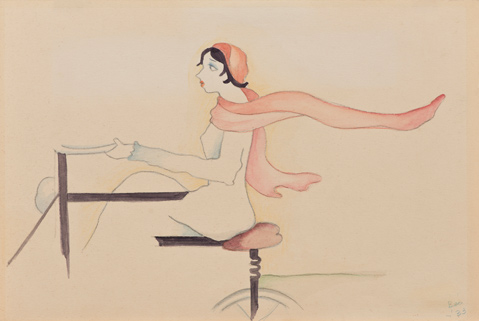Review: Drawings by Beatrice Wood at the Santa Barbara Museum of Art
Another Side of Ojai's Mama of Dada

It’s been a big year for women and drawing at the Santa Barbara Museum of Art. First there were two excellent shows examining the drawings of Alice Aycock and Michelle Stuart, and now there’s this relatively small but nevertheless illuminating exhibit of drawings by the Ojai ceramicist Beatrice Wood. Best known for her lusterware pottery, Wood has also long enjoyed a substantial reputation not only as a craftsperson but also as a rabble-rousing Dada-style troublemaker.
Born into wealth and privilege, the rebellious Wood spent a good portion of her long life warding off creditors and eking out an existence from one art sale to the next. After experiencing the heady liftoff of surrealism in New York as a friend and confidante of Marcel Duchamp, Wood went West, first to Los Angeles, where she cultivated a wide circle of artistic and celebrity acquaintances, and then to Ojai, where she studied Eastern philosophy under Krishnamurti and eventually settled in for several decades of unusual productivity at the pottery wheel.
In Living in the Timeless, an exhibition made possible by the loan of a collection amassed by longtime Wood supporter and fearless scholar of early Dada Francis Naumann, both aspects of Wood — her quirky, faux-naïve aesthetic and her playful, flirtatious sense of humor — are on full display. In addition to a selection of drawings, many of them employing colored pencils or watercolors in addition to graphite, there are also several examples of her whimsical work as a sculptor in clay. These small, childlike figures exist in sharp contrast to the elegance and fine finish of her more traditional chalices and bowls. In one particularly striking set of figures, Wood portrays herself and second husband Steve Hoag on the occasion of their Las Vegas wedding as a hilariously un-together pair of newlyweds. While these figurines seem to mock the tradition of miniatures as cake decorations, another figure in the same vitrine depicting a topless and very sexy Helen Freeman, a friend and frequent travel companion of Wood, shows that perhaps her true passion lay elsewhere. Never one to shy away from an innuendo, Wood composed a book in the same period that she titled Touching Certain Things. Drawings from the book include a salacious portrait of Wood in bed with and ogling a sleeping Freeman. This scandalous early-20th-century image of same-sex desire is called simply “… how lucky men are.”
When sketching, Wood relies heavily on gestures, the most apparent being the use of negative space in portraits — using one line to define both the nose and the space where the eye should be, for example, and the dislocation of limbs from their proper connections. The latter move reaches its logical endpoint in “Dance Craze,” a drawing from 1982 that shows disembodied legs entwined in various poses designed to exploit the suggestive potential of isolated limbs. At their most successful, Wood’s drawings pair the simple ironies of the cartoon form with the disruptive tendencies of her contemporaries in the fields of Dada and surrealism. “Holiday,” from 1933, is a composition in watercolor and pencil showing a rather manic-looking Wood at the wheel of a car with her husband in the passenger seat. The bizarre placement of an electric power line across the middle of the car’s windshield lends a certain frisson of shock — one of Wood’s favorite terms — to an otherwise familiar situation. The ultimate sensation to be derived from this exhibition is similar to the one suggested by this piece — a fast and wild ride with a spark plug doing the driving.



